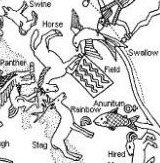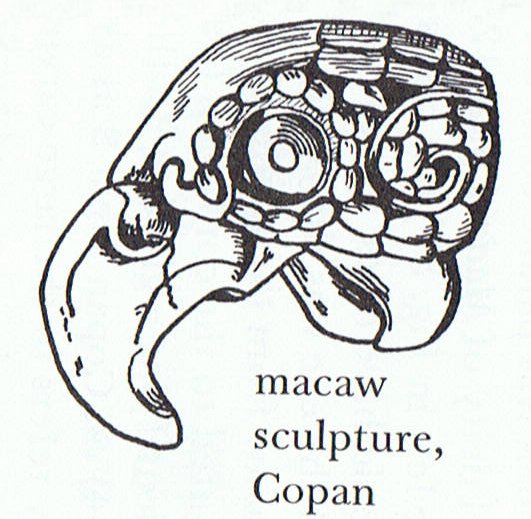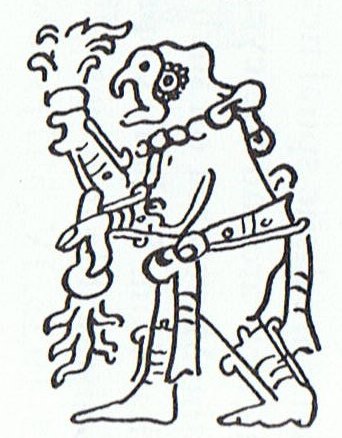408. The pair of glyphs at Polaris late
on side b on the G tablet are quite similar to the
pair of glyphs at Aldebaran (*68) early on side a, and
day 148 (80 + 68) was 28 May when Itzam-Yeh (Wuqub-Kaqix,
7-Macaw) was defeated:
... the
Palenque scribes repeated Creation again and described
it as 'it was made visible, the image at Lying-down-Sky,
the First-Three-Stone-Place'. Then we learned that
five hundred and forty-two days later (1.9.2 in the
Maya system), Hun-Nal-Ye 'entered or became the
sky' (och ta chan). This 'entering' event
occurred on February 5, 3112 B.C. The act of 'entering
the sky' is recorded on another extraordinary painted
pot.

This pot
depicts one of the Hero Twins (One-Ahaw in the Classic
texts and One-Hunaphu in the K'iche' Popol Vuh)
and a great bird who is trying to land in a huge ceiba
tree heavy with fruit. This mythical bird is
Itzam-Yeh, Classic prototype of Wuqub-Kaqix,
'Seven-Macaw', of Popol Vuh fame. In that story,
in the time before the sky was lifted up to make room
for the light, the vainglorious Seven-Macaw imagined
himself to be the sun. Offended by his pride, the Hero
Twins humbled him by breaking his beautiful shining
tooth with a pellet from their blowgun. This pot shows
One-Ahaw aiming at the bird as he swoops down to land in
his tree. As Itzam-Yeh lands on his perch, the
text tells us he is 'entering or becoming the sky'. This
particular 'sky-entering' is not the one mentioned in
the Palenque text. It is the final event that occurred
in the previous creation before the universe was remade.
Before the sky could be raised and the real sun revealed
in all its splendor, the Hero Twins had to put the false
sun, Itzam-Yeh, in his place. If the date on this
pot corresponds to that pre-Creation event, as we
believe it does, then Itzam-Yeh was defeated in
12.18.4.5.0 1 Ahaw 3 K'ank'in (May 28, 3149
B.C.). After the new universe was finally brought into
existence, First Father also entered the sky by landing
in the tree, just as Itzam-Yeh did
...
|
Itzam-Yeh
defeated |
28 May
(148),
3149 BC |
35 years - 1 week = 25 *
73 days |
|
First 3-stone
place |
21 May
(141),
3114 BC |
zero |
|
Creation of
our present world |
13 August
(225),
3114 BC
|
84 = 12 weeks
→ Julian equinox |
|
Hun-Nal-Ye
became the sky |
5 February
(36),
3112 BC
|
84 + 2 * 229 = 2 * 271 =
days |
|
21 May, 3114 BC - 13 August,
3114 BC = 225 - 141 = 84 (=
12 * 7).
21 May, 3114 BC - 5
February, 3112 BC = (366 -
225) + 365 + 36 = 141 + 401
= 542,
which 'happens to be' the
sum of 365 days and 6 * 29½
nights. |
|
204 |
1-27 (392) |
1-28 |
36 |
|
FEBR 11 (42) |
12 (408) |
 |
 |
|
Gb7-24 |
Gb7-25 (206)
|
|
Polaris |
Sheratan (*27) |
|
April 16 (471) |
17 (107 = 472 - 365) |
|
'March 20 (*364) |
Gregorian equinox |
|
"March 6 (*350) |
7 (66) |
|
Benetnash |
*209 (= *27 + *182) |
|
242 |
| zero |
2 |
3-9 |
3-10 (69) |
137 |
7-26 |
7-27 |
7-28 |
7-29 (210) |
84 |
| MARCH 24 (83) |
Julian equinox |
AUG 10 |
11 |
12 |
13 (225) |
 |
 |
 |
 |
 |
 |
| Ga1-3 |
Ga1-4 |
Ga6-2 |
Ga6-3 |
Ga6-4 |
Ga6-5 (145) |
| *67 |
Aldebaran |
κ Octantis |
*207 |
Benetnash |
*209 |
| *250 |
Han = ζ Ophiuchi |
Alseiph |
*25 |
Polaris |
Sheratan (*27) |
| 230 |
We could therefore try to apply the
measure 70 days before the time of rongorongo to
the defeat of Itzam-Ye, because the precessional
distance between 28 May
(148),
3149 BC, and 5 February
(36),
3112 BC, is not much. And also because the fate of Itzam-Ye
should be intertwined with that of Hun-Nal-Ye
taking over his
position as 'top bird'.
|
64 + 6 = 70 DAYS BEFORE THE TIME OF
RONGORONGO: |
|
34 = 40 - 6 |
35 |
Hun-Nal-Ye became the sky |
37 |
38 |
|
400 = 366 + 40 - 6 |
401 |
408 - 6 = 402 |
403 |
404 |
|
CLOSE TO THE SUN (at the time of the Bull): |
|
Jan 24 (= 40 - 16) |
25 (= 105 - 80) |
26 (392 = 408 - 16) |
27 (393 - 366) |
28 |
|
16 DAYS LATER WHEN THE STAR OBSERVATION HAD
BECOME POSSIBLE: |
|
FEBR 9 (40 = 31 + 9) |
10 (407 = 41 + 366) |
11 (408 = 392 +
16) |
12 (*329 = 409 - 80) |
13 (☼326
= 410 - 84) |
 |
 |
 |
 |
 |
|
Gb7-22 |
Gb7-23 (204) |
Gb7-24 |
Gb7-25 (229 +
206) |
Gb7-26 (436) |
|
ALSEIPH (Scimitar) = φ Persei
(24.5), τ Ceti (24.7) |
no star listed (25) |
ANA-NIA-10 (Pillar-to-fish by)
χ
Ceti (26.1),
POLARIS =
α Ursae Minoris, BATEN KAITOS (Belly of the
Fish) = ζ Ceti (26.6),
METALLAH (Triangle) =
α
Trianguli
(26.9) |
Al Sharatain-1 /
Ashvini-1 /
Bond-16 (Dog) /
Mahrū-sha-rishu-ku-1 (Front of the Head of
Ku)
SEGIN =
ε
Cassiopeia,
MESARTHIM =
γ
Arietis,
ψ
Phoenicis (27.2),
SHERATAN (Pair of Signs) =
β
Arietis,
φ
Phoenicis (27.4)
*351 = *27.4 - *41.4 |
ι Arietis (28.0), λ Arietis (28.2), υ Ceti
(28.8) |
|
4-14 (84 + 20 = 104) |
April 15 (*25) |
16 (471 = 365 + 106) |
17 (107) |
(*393 = *352 +
*41) |
|
°April 10 (100) |
11 (466) |
12 |
13 |
14 (104) |
|
'March 18 |
19 (78) |
20 (*364) |
0h |
22 (446 = 432 + 14) |
|
"March 4 |
5 (64) |
6 (*350) |
7 (107 - 41 = 66) |
8 (432 = 365 + 67) |
 |
... The precessional distance down
from the time of rongorongo to that of the First
Father can be calculated as around (1842 AD + 3112
BC) /
26000 * 365.25 = 70 right ascension days, or as 6
days more than 64 = 10 days less than 80. It was
evidently Polaris who rose with the Sun when
Hun-Nal-Ye became the sky, and it would have
been in day 392 (January 26) - 10 = 382 (January 16)
when the companion star of Polaris (*26.6), viz. the
Belly of the Fish (Baten Kaitos,
ζ Ceti, *26.6)
would have returned to visibility after the close
encounter with the Sun in December 31. Polaris never
sank below the horizon and it was therefore outside
the cycles of heliacal risings and settings ...
|
64 + 6 = 70 DAYS BEFORE THE TIME OF
RONGORONGO: |
|
81 - 6 = 75 |
76 |
77 |
78 |
79 |
80 |
|
441 = 75 + 366 |
448 - 6 = 442 |
443 |
444 (☼360) |
445 |
446 |
|
CLOSE TO THE SUN (at the time of the
Bull): |
|
March 4 (63) |
5 (432 = 350 + 82) |
6 |
7 (☼350) |
8 |
9 |
|
16 DAYS LATER WHEN THE STAR OBSERVATION
HAD BECOME POSSIBLE: |
|
MARCH 22 (81) |
23 (448 = 366 + 82) |
24 |
JULIAN
EQUINOX |
26 (*5) |
27 |
 |
 |
 |
 |
 |
 |
|
Ga1-1 |
Ga1-2 |
Ga1-3 |
Ga1-4 |
Ga1-5 |
Ga1-6 |
|
Net-19 (Crow)
AIN (Eye) = ε
Tauri,
θ¹ Tauri, θ² Tauri (65.7) |
no star listed (66) |
no star listed (67) |
Rohini-4 (The Red One) /
Pidnu-sha-Shame-4 (Furrow of Heaven)
/
ANA-MURI-2 (Rear pillar - at the foot of
which was the place for tattooing)
ALDEBARAN = α Tauri
(68.2),
THEEMIN = υ² Eridani
(68.5) |
no star listed (69) |
no star listed (70) |
|
May 25 (145) |
26 |
27 |
28 (148) |
29 |
30 |
|
°May 21 (141) |
22 |
23 |
24 |
25 |
26 |
|
'April 28 (118) |
29 |
30 |
May 1 |
2 |
3 |
|
"April 14 (104) |
15 |
16 |
17 |
18 |
19 |
However, day 148 (28 May, 3149 BC) was not
at Ga1-4 (May 28, 1842 AD). We need to move ahead with 148 - 78 =
70 days and 4 + 70 = glyph number 74. And should we
alternatively move ahead from day 36 (5 February,
3112 BC) with
148 - 36 = 112 days we will also arrive at FEBRUARY 11
(42) + 112 = 154 (JUNE 3) = 80 + 74. This place
was not at the tail of Ursa Major (Itzam-Yeh) but at
his
front end:
|
143 |
144 = 150 - 6 |
290 / 2 |
146 |
147 (☼63) |
Itzam-Yeh
defeated,
28 May
(148),
3149 BC |
149 |
|
MAY 29 |
30 (150) |
31 |
JUNE 1 |
2 (*73) |
3 |
4 |
 |
 |
 |
 |
 |
 |
 |
|
Ga3-10 |
Ga3-11 |
Ga3-12 |
Ga3-13 (72) |
Ga3-14
→ π |
Ga3-15 |
Ga3-16 |
|
γ Pyxidis (133.6) |
ζ Hydrae (134.1), ρ Cancri (134.2),
ζ Oct. (134.3), ο Cancri (134.6), δ
Pyxidis (134.9) |
ACUBENS = α Cancri,
TALITHA BOREALIS = ι Ursae Majoris
(135.0), σ Cancri (135.2), ρ Ursa
Majoris (135.6) |
ν Cancri (136.0),
TALITHA AUSTRALIS = κ Ursae Majoris
(136.1), ω Hydrae (136.8) |
9h (137.0)
σ¹ Ursa Majoris (137.0), κ Cancri
(137.3), τ Cancri (137.4),
ALSUHAIL (al Wazn, of the Weight) =
λ Velorum
(137.5), σ² Ursa Majoris (137.6), τ
Ursa Majoris (137.7), ξ Cancri
(137.8)
*96 = *137.4 - *41.4 |
κ Pyxidis (138.0), ε Pyxidis (138.5) |
π
Cancri (139.2),
MIAPLACIDUS =
β
Carinae
(139.3),
TUREIS (Little Shield) =
ι
Carinae
(139.8) |
|
Aug 1 |
2 (150 + 64) |
3 |
4
(216) |
5 |
6 |
7 |
|
°July 28 |
29 (*130) |
30 |
31
(212) |
°Aug 1 |
2 (☼130) |
3 |
|
'July 5 |
6 (*107) |
7 |
8 |
9 |
10
(*111) |
11 |
|
SOLSTICE |
"June 22 (*93) |
23 |
ST
JOHN'S DAY |
25 |
26 (6 * 29½) |
27 |

 |
And therefore the First 3-stone place
(time zero) should be a week earlier among the
glyphs. 35 years - 1 week = 25 * 73 days =
1825 days = 21 May
(141)
3114 BC - 21 May
(141)
3114 BC:
|
145 - 6 = 139 |
140 (*60) |
First 3-stone
place,
21 May
(141),
3114 BC |
142 (☼58) |
|
MAY 25 (290 / 2) |
26 (*66) |
27 (131 + 16 = 147) |
28 (☼64) |
 |
 |
 |
 |
|
Ga3-6 |
Ga3-7 (66) |
Ga3-8 |
Ga3-9 (132 - 64) |
|
Āshleshā-9 (Embrace) /
Willow-24 (Stag)
π¹ Ursa Majoris,
δ Hydrae (129.6),
AL MINHAR
AL SHUJĀ = σ Hydrae,
MUSEIDA = π² Ursae
Majoris
(129.9)
RAS
ALHAGUE (α Ophiuchi)
|
Al Nathrah-6 (Gap)
BEEHIVE
(Exhalation of Piled-up Corpses)
= ε Cancri,
η Pyxidis (130.4),
XESTUS = ο Velorum
(130.5), ζ Pyxidis (130.7),
ASCELLUS BOREALIS = γ Cancri,
β Pyxidis (130.9)
*89 = *130.4 - *41.4 |
Extended Net-26a (Ox) /
Arkū-sha-nangaru-sha-shūtu-12
(Southeast Star in the Crab)
η
Hydrae (131.0),
ASCELLUS
AUSTRALIS =
δ
Cancri
(131.4),
KOO SHE (Bow and Arrow) =
δ
Velorum
(131.6),
α
Pyxidis (131.8),
ε
Hydrae
(131.9)
*90 = *131.4 - *41.4 |
ι Cancri (132.0),
ρ Hydrae
(132.4)
*91 = *132.4 - *41.4 |
|
July 28 |
29 |
30 (*131) |
31 (212) |
|
°July 24 |
25 |
26 (*127) |
27 (208) |
|
'July 1 |
2 |
3 (*104) |
4
(185) |
|
"June 17 |
18 |
19 (*90) |
20 (171) |

A man had a daughter who
possessed a wonderful bow and
arrow, with which she was able
to bring down everything she
wanted. But she was lazy and was
constantly sleeping. At this her
father was angry and said: 'Do
not be always sleeping, but take
thy bow and shoot at the navel
of the ocean, so that we may get
fire.' The navel of the ocean
was a vast whirlpool in which
sticks for making fire by
friction were drifting about. At
that time men were still without
fire. Now the maiden seized her
bow, shot into the navel of the
ocean, and the material for
fire-rubbing sprang ashore. Then
the old man was glad. He kindled
a large fire, and as he wanted
to keep it to himself, he built
a house with a door which
snapped up and down like jaws
and killed everybody that wanted
to get in. But the people knew
that he was in possession of
fire, and the stag determined to
steal it for them. He took
resinous wood, split it and
stuck the splinters in his hair.
Then he lashed two boats
together, covered them with
planks, danced and sang on them,
and so he came to the old man's
house. He sang: 'O, I go and
will fetch the fire.' The old
man's daughter heard him
singing, and said to her father:
'O, let the stranger come into
the house; he sings and dances
so beautifully.' The stag landed
and drew near the door, singing
and dancing, and at the same
time sprang to the door and made
as if he wanted to enter the
house. Then the door snapped to,
without however touching him.
But while it was again opening,
he sprang quickly into the
house. Here he seated himself at
the fire, as if he wanted to dry
himself, and continued singing.
At the same time he let his head
bend forward over the fire, so
that he became quite sooty, and
at last the splinters in his
hair took fire. Then he sprang
out, ran off and brought the
fire to the people.(From
the Catlo'Itq in British
Columbia according to Hamlet's
Mill.)

 |
Howevcr, time zero could
also have referred to Betelgeuze (*83),
which at the time of Bharani rose with
the Sun in "June 12 (He Maro 12)
and returned to visibility 16 days later
at Ga3-17:
... The earliest depiction that has been
linked to the constellation of Orion is
a prehistoric (Aurignacian) mammoth
ivory carving found in a cave in the Ach
valley in Germany in 1979.
Archaeologists have estimated it to have
been fashioned approximately 32,000 to
38,000 years ago ... The artist cut,
smoothed and carved one side (A)
and finely notched the other side (B)
and the edges. Side A contains
the half-relief of an anthropoidal
figure, either human or a human-feline
hybrid, known as the 'adorant' because
its arms are raised as if in an act of
worship.On
side B together with the four
edges is a series of notches that are
clearly set in an intentional pattern.
The edges contain a total of 39 notches
in groups of 6, 13, 7 and 13. A further
49 notches on side B are
arranged in four vertical lines of 13,
10, 12 and 13 respectively plus a
further notch that could be in either of
the middle two lines ... The grouping of
the notches on the plate suggests a
time-related sequence. The total number
of notches (88) not only coincides with
the number of days in 3 lunations (88.5)
but also approximately with the number
of days when the star Betelgeuse (α
Ori) disappeared from view each year
between its heliacal set (about 14 days
before the spring equinox around 33,000
BP) and its heliacal rise (approximately
19 days before the summer solstice) ...

 |
 |
|
Ga3-17 |
maitaki |
|
Maitaki.
Clean,
neat, pure, pretty,
nice, beautiful,
handsome; tagata rima
maitaki,
clean-handed man,
correct man. Vanaga. 1.
Good. Henua maitaki
= the good earth. 2.
Shine. Marama maitaki
= the shining moon.
Barthel. Ce qui est bon.
Jaussen according to
Barthel. Meitaki,
good, agreeable,
efficacious, excellent,
elegant, pious, valid,
brilliant, security, to
please, to approve (maitaki);
ariga meitaki,
handsome, of pleasant
mien; mea meitaki ka
rava, to deserve;
meitaki ke,
marvelous, better.
Hakameitaki, to make
good, to amend, to do
good, to bless, to
establish.
Meitakihaga,
goodness. PS Pau.:
maitaki, good. Mgv.:
meitetaki,
beautiful, good. Mq.:
meitai, good,
agreeable, fit, wise,
virtuous. Ta.:
maitaiki, good,
well. Niuē:
mitaki,
good. Maitakia,
clean. Churchill. |
|
140 - 6 = 134 |
141 - 6 = 135 |
136 → Atlas & Alcyone |
137 |
138 (☼54) |
|
MAY 20 (140) |
21 (*61) |
22 |
23 |
24 (144) |
 |
 |
 |
 |
 |
|
Ga3-1 |
Ga3-2 (61) |
Ga3-3 |
Ga3-4 |
Ga3-5 |
|
AL TARF (The End) =
β
Cancri
(124.3)
RAS
ALGETHI (α Herculis
|
χ Cancri
(125.2),
BRIGHT FIRE = λ Cancri
(125.4) |
AVIOR = ε Carinae
(126.4), φ Cancri (126.8) |
ο Ursa Majoris (127.4) |
Pushya-8 (Nourisher)
υ Cancri (128.1),
θ CANCRI
(128.2) |
|
July 23 (204) |
July 24 (*125) |
25 |
26 |
27 (208) |
|
°July 19 (200) |
°July 20 (*121) |
21 |
22 / 7 → π |
23 (204) |
|
'June 26 (177) |
'June 27 |
28 |
29 (*100) |
SIRIUS |
|
"June 12 (*83) |
→ Julian equinox |
14 (530 = 165 + 365) |
He Maro 15 (18 * 29½) |
16 |
|
Makoi
got up and began to familiarize
himself with the (new) land.
(This took place) on the
fifteenth day of the month of
June ('Maro'). He went
toward the sheer face of the
rocks (titi o te opata),
was astonished (aaa),
came up to the middle (of the
outer rim of the crater), and
stood at the very edge.

He looked down and saw the 'Pu
Mahore of Hau
Maka' (on the coast) and
said, 'There it is, the hole of
the mahore fish of Hau
Maka!' He turned his face
and looked toward the back
(i.e., in the direction of the
crater). No sooner had he seen
how the dark abyss opened up
(below him), when a fragrant
breeze came drifting by. Again
Makoi said, 'This is the
dark abyss of Hau Maka'.
He turned around, walked on in
utter amazement, and arrived at
the house. He spoke to Ira,
'Hey you, my friends! How
forgetful we (truly) are. This
place is adequate (? tau
or 'beautiful'), the dark abyss
lies there peacefully!' Ira
replied, 'And what should that
remind us of up here?' All arose
and climbed up. They went on and
arrived; they all had a good
look (at the inside of the
crater). They returned home and
sat down. Night fell, and they
went to sleep.
 |
 
|




























